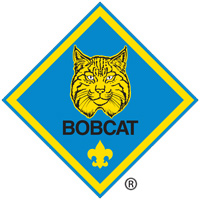
Bobcat
No matter what age or grade a boy joins Cub Scouting, he must earn his Bobcat badge before he can advance to the rank of Tiger, Wolf, Bear, or Webelos. A boy must complete the Bobcat requirements, which include:
- Learn and say the Cub Scout motto, the Scout Oath, and the Scout Law and tell what they mean;
- Show the Cub Scout sign, salute, and handshake and tell what they mean; and
- With your parent or guardian complete the exercises in the pamphlet How to Protect Your Children from Child Abuse: A Parent's Guide.
(LIONS-Kindergarten-see below)
--------------------------------------------------------------------------------------------------------------------------
Tiger

The Tiger rank is for boys who are in or starting first grade or are age 7. To earn the Tiger badge, a boy must complete six required adventures with his den or family and one elective adventure of his den or family’s choosing. As the boy completes each adventure, he will receive the adventure loop for that adventure, which he can wear on his belt. When the boy has completed the seven required adventures, he can receive the Tiger badge. The Tiger badge is given to the boy’s adult partner at a pack meeting. Then, during a grand ceremony, the adult gives the badge to the boy.
After he has earned the Tiger badge, a Tiger Scout can work on the remaining 12 Tiger electives until he finishes first grade (or turn 8 years old). He can choose elective adventures that may show him new hobbies and teach him skills that will be useful during his Boy Scout years. When he completes an elective adventure, he receives an additional adventure loop to wear on his belt.
Wolf

The Wolf rank is for boys who are in or starting second grade (or who are 8 years old). To earn the Wolf badge, a boy must complete six required adventures and one elective adventure. His parent or guardian and den leader approves each requirement by signing his book, and the boy receives an adventure loop for each adventure. When the boy has met all requirements, the Wolf badge is presented to his parent or guardian at the next pack meeting. During an impressive ceremony, the parent or guardian then presents the badge to the boy.
After he has earned the Wolf badge, a Wolf Scout can work on the remaining 12 Wolf electives until he finishes second grade (or turns 9 years old). He can choose elective adventures that may show him new hobbies and teach him skills that will be useful during his Boy Scout years. When he completes an elective adventure, he receives an additional adventure loop to wear on his belt.
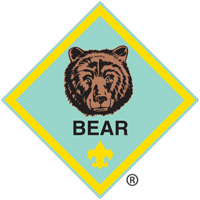
Bear
The Bear rank is for boys who are in or starting third grade (or who are 9 years old). To earn the Bear badge, a boy must complete six required adventures and one elective adventure. His parent or guardian and den leader approves each requirement by signing his book, and the boy receives an adventure loop for each adventure. When the boy has met all requirements, the Bear badge is presented to his parent or guardian at the next pack meeting. During an impressive ceremony, the parent or guardian then presents the badge to the boy.
After he has earned the Bear badge, a Bear Scout can work on the remaining 12 Bear electives until he finishes third grade (or turn 10 years old). He can choose elective adventures that may show him new hobbies and teach him skills that will be useful during his Boy Scout years. When he completes an elective adventure, he receives an additional adventure loop to wear on his belt.
Webelos
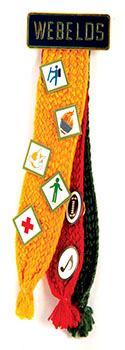
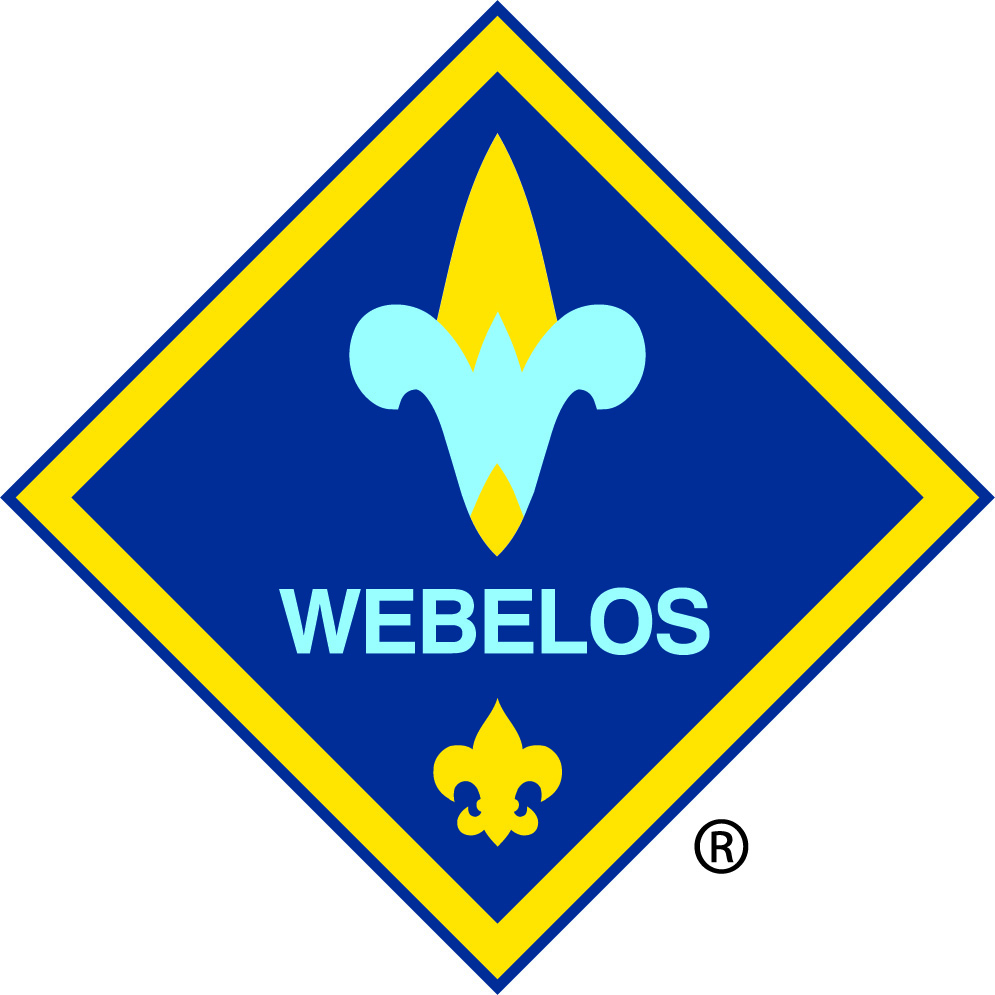
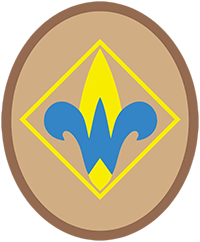
Webelos dens are for boys who are in or starting fourth grade (or reached age 10). Webelos Scouts get to work on the five required Webelos adventures and choose two of the 18 elective adventures that are shared by the Webelos and Arrow of Light ranks.
When a boy has done the requirements for an adventure, the Webelos den leader, rather than a parent, approves most of the adventures. For each adventure a boy completes, he receives a pin to wear on the Webelos colors or on his hat. After completing seven adventures, including five required adventures and two elective adventures, a Scout can receive the Webelos badge.
After he has earned the Webelos badge, a Webelos Scout can work on the remaining 18 shared Webelos and Arrow of Light electives until he finishes fourth grade (or turns 11 years old). He can choose elective adventures that may show him new hobbies and teach him skills that will be useful during his Boy Scout years. When he completes an elective adventure, he receives an additional adventure pin to wear on the Webelos colors or on his hat.
Arrow of Light

The highest rank in Cub Scouting is the Arrow of Light. Earning this rank prepares a Webelos Scout to become a Boy Scout. Scouts must complete four required adventures and three elective adventures to earn the Arrow of Light rank. For each adventure a boy completes, he receives a pin to wear on the Webelos colors or on his hat.

The Arrow of Light badge is the only Cub Scout badge that can be worn on the Boy Scout uniform when a boy graduates into a troop. Adult leaders who earned the Arrow of Light rank when they were young may also show their achievement by wearing a special square knot on their adult uniform.
---------------------------------------------------------------------------------------------------------------------------------------------------------------------------------------------------------
WAIT....WHAT ABOUT KNDERGARtEN?!?!?!?!
Only AURORA PACK has you covered........... join today 513-818-CUBS

In the 1939 film The Wizard of Oz, Dorothy famously imagined a forest full of “lions and tigers and bears—oh my!” Throw in some Wolves and Webelos, and you may soon have an accurate description of Cub Scouting in many parts of the country.
Beginning this past fall, select Boy Scout councils will test the new Lion program for 5-year-old kindergarten-age boys. Lions is designed to offer a low-key introduction to Cub Scouting, giving families a Scouting option at a time when many would otherwise commit to sports programs that start in kindergarten.
“Often, children become attached to lifelong activities at an early age—that is certainly a goal we would have, as we know the long-term benefits of Scouting involvement include strong asset development in the areas of character and leadership,” says Chief Scout Executive Mike Surbaugh. “However, we also know that when youth participate in numerous activities at an early age, and miss joining Scouting, they are unlikely to do so at adolescence.”
Like Tigers for first-graders, Lions is built around parent-son pairs who share leadership within the den. Leading each Lion den will be the Lion guide, an experienced adult Cub Scout leader. Den activities, which have been developed by experts in Cub Scouting and child development, will introduce Scouting activities and values in age-appropriate ways.
Lions will be part of a Cub Scout pack like their older counterparts; however, their participation in pack activities will be limited. They won’t participate in fundraising projects, overnight outings, or activities like shooting sports that are beyond their ability. Instead, they will attend two or three pack meetings, as well as age-appropriate special activities. They’ll also wear a Lion T-shirt instead of a Cub Scout uniform and will earn stickers instead of belt loops.
The National Lion Pilot builds on the work of the Northern Star Council, which first began testing Lions several years ago. Results there have indicated that Lions could have a positive effect on the retention of Cub Scouts—and their parents. On the Bryan on Scouting blog, one former Lion leader reported that nine of her 11 boys are still involved in Scouting three years later. “They are the most engaged boys in my den, and their parents are the ones who are most likely to jump in and get involved,” she wrote. “No signs of burnout here in the Twin Cities in my pack.”
Burnout is one issue the pilot will explore. Test councils will be looking not just at how well the program serves today’s kindergarteners but how likely those boys are to remain involved throughout their Cub Scout years and into Boy Scouting. “What will be important to learn in the next few years, if the initial entry point works at the kindergarten-age level, is will this cause losses at a different age, or will the program keep the same retention all the way through to Boy Scouting?” Surbaugh says.
If Lions turns out to enhance retention, look for the program to be around for generations to come, much like Tigers, which was introduced in 1983. Then the Cowardly Lion won’t be the only lion in the forest.